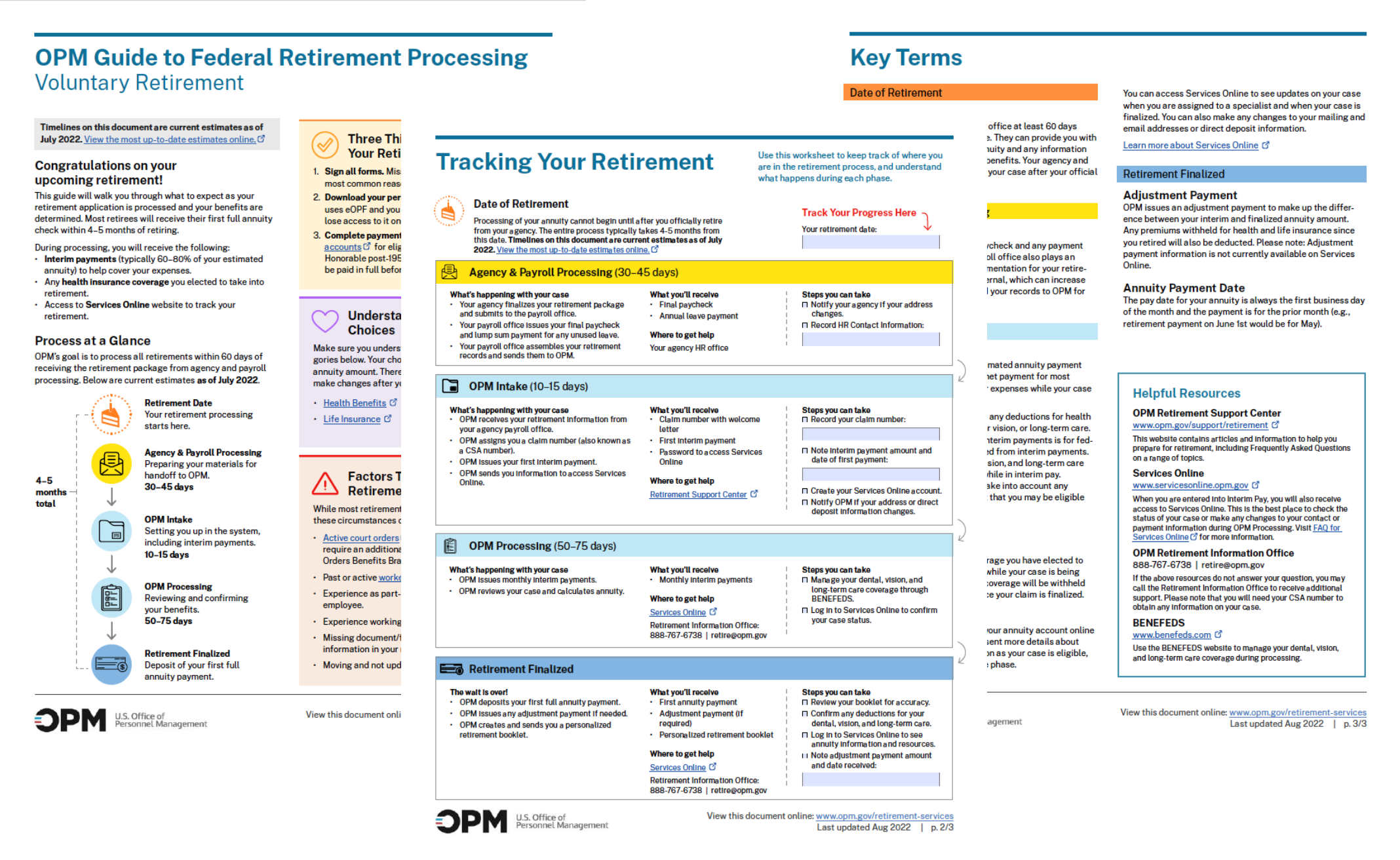When federal employees retire, they expect a smooth transition. Instead, their cases can take months to process due to backlog, overly complex policies, outdated legacy systems, and the multiple agencies involved. This waiting time leaves customers anxious, confused, and calling both their home agency and OPM for answers. OPM’s call center had become overloaded, with staff spending hours fielding basic status questions and explaining the process, which hindered support for retirees with more complex needs.
We weren’t going to fix decades of policy and backlog overnight. But we could focus on the retiree experience: helping people understand what to expect, where to go with questions, and decrease their anxiety, frustration, and financial vulnerability. Our team set out to explore ways to improve the customer service experience for people nearing and/or starting retirement.

Through research and journey mapping, we found retirees’ expectations were shaped by misleading information long before OPM considered them “customers.” I helped reframe the team’s perspective through co-design workshops, where we aligned on priorities and generated solutions.
Two concepts rose to the top:
– A digital case tracker (like Domino’s pizza tracker)
– A “Getting Started” guide to set expectations early
I led the design and content strategy for these tools: facilitating workshops, untangling complex policy into clear guidance, and designing early prototypes. To jumpstart a digital tracker, I advocated starting with a PDF self-tracker as a low-barrier way to test content before pursuing a digital build. We tested the prototypes with retirees, HR staff, and frontline call center employees, which led us to simplify and merge the two concepts into a single tool.

Based on our research goals, we targeted a range of people to speak with and learn more about the federal retiree experience.
I leveraged visual storytelling with journey maps, interview quotes, and pairing quantitative data with qualitative insights. This helped us expand OPM’s perspective of where the retiree experience begins and how that impacts their expectations and experience interacting with OPM Retirement Services.

I facilitated collaborative workshops and design activities that engaged the partner team to co-design and prioritize solutions based on objectives and design criteria that supported an improved customer experience alongside business goals.

I led the development of two prototypes to test with customers, each targeting a different moment in the customer experience. By designing as PDFs rather than web content, it forced us to keep content succinct and allowed OPM to launch a pilot with select agencies to evaluate and iterate before navigating website constraints.
We created a clear, three-page Retirement Quick Guide that retirees and HR staff loved. We handed off a package to set up Retirement Services to run a pilot with the new tool, including 508-compliant PDF, testing outline, and resources for iteration. Testing showed it provided clarity, reassurance, and better direction during a stressful time. In its first year, the tool had 58K page views, 21K downloads, and a 100% approval rating from agency benefit officers. Our partner continued to iterate on the concept, creating a website and video to further support retirees.
“Absolutely would share...having something that we use consistently across agency would be great. We have separate HR offices, all manage on their own…so having guidance on processing time so someone would know what to expect is very helpful.”
– Agency HR Specialist
Perhaps most importantly, the work built capacity inside OPM: staff began pushing back on leadership’s instinct to sugarcoat timelines, citing our research to argue for honesty and showing that transparency matters more than false optimism. Our work was applauded agency wide and received the 2024 OPM Director’s Award for Excellence in Customer Service.

Our final prototype included: a simple timeline overview (which didn't previously exist), reminders on final tasks and key decisions points, links to important resources, tips to avoid delays, a self tracker to follow progress of your case, and a glossary of key terms.

After the pilot program, OPM updated their website to create a new Retirement Center section, which featured the content from our Retirement Quick Guide as a primary page.
After decades of stalled modernization attempts, this project gave OPM Retirement Services a visible win. It sparked greater investment in customer experience improvements and human-centered design across the agency, setting the stage for more lasting change.
“This project has been eye-opening for our organization. We're seeing opportunities for improving customer experience. We are not done...”
– Retirement Services team member
Team: Lab at OPM
Project Lead: Paul Roberts
Service Designer: Kelly Bryan
Researcher: Andrew Lee
Researcher: Erika Lindsay